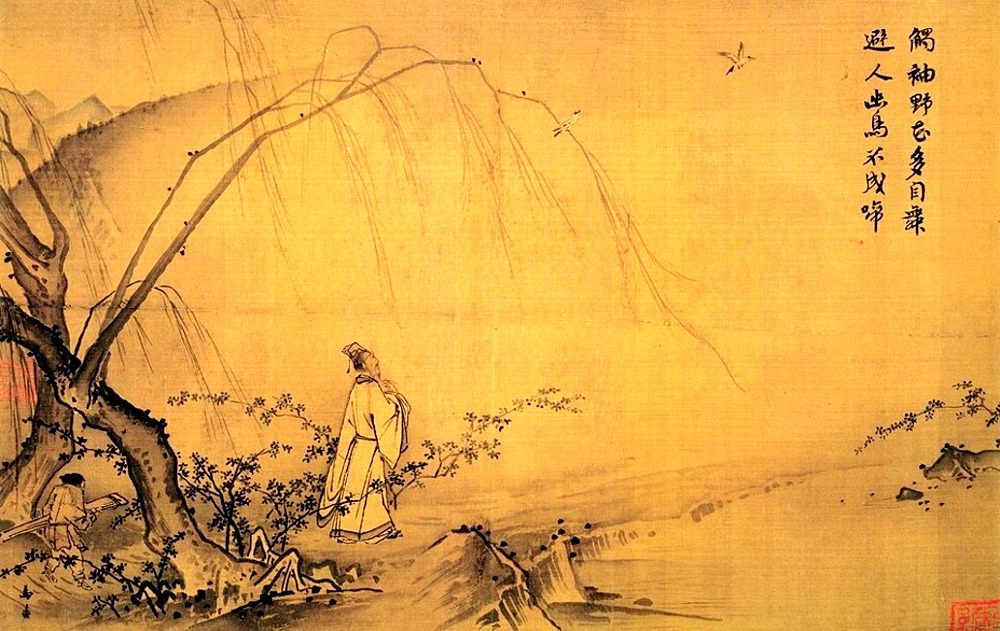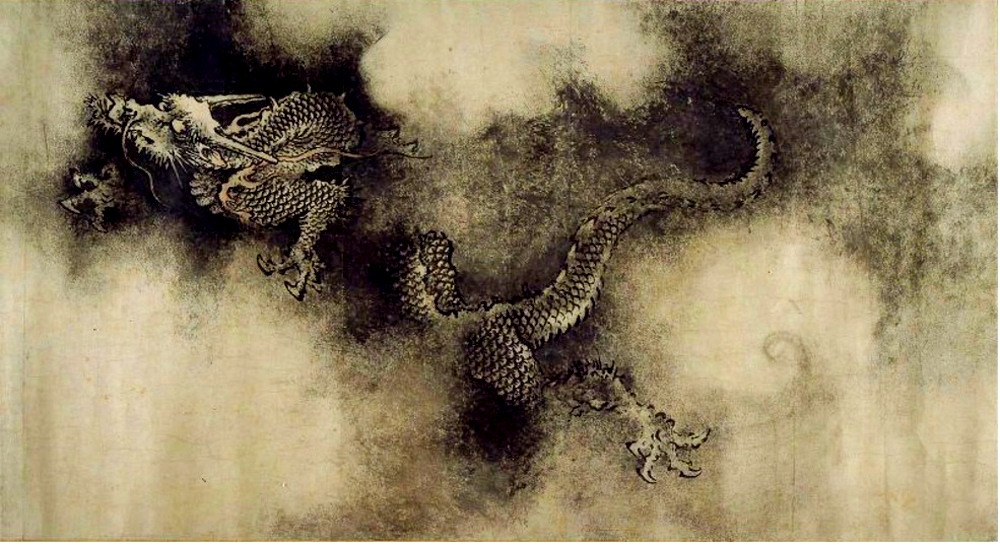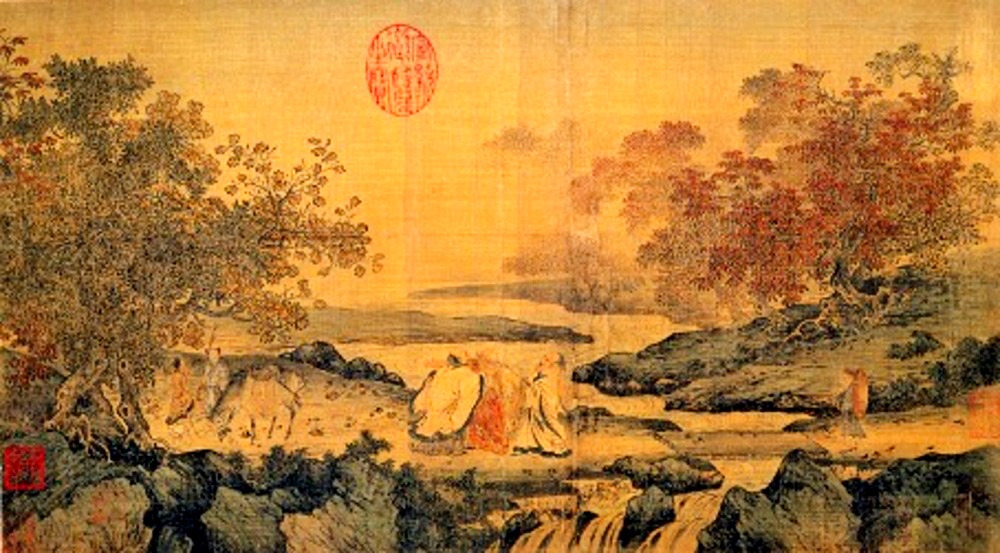This item is part of our special edition”Deciphering Chinese Buddhism”
You can check out the first part by clicking here
In the first part of this article, we examined the origins of Daoism, from its roots in ancient China to its configuration during the Han and Jin dynasties. It was during this period that, gradually, his initial encounter with Buddhism developed. We address some of its fundamental texts, the key concepts, such as the Dào, wow and Here, as well as some of its main practices. On this basis, in this issue we analyze the impact and fascinating syntheses that emerged from the interaction between these two traditions. This encounter not only gave rise to distinctive forms of Buddhism in China, such as Chan, but it also enriched and profoundly transformed Daoism.

Daoism on the eve of the encounter with Buddhism
At the end of the Eastern Han dynasty (2nd century CE), Buddhism began to be established in China in a context in which Daoism already presented a rich diversity of expressions. During this period, these Daoist traditions increasingly contributed to shaping, enriching and promoting the religious life of diverse communities.
On the one hand, speculations based on texts already classical at the time, such as Daodejing And andThe Zhuangzi, were about the nature of reality, spontaneous action (Wúwei) and the confines of ordinary knowledge, showing an interconnected perspective of the cosmos. On the other hand, religious movements of a Daoist orientation, which were beginning to take shape, emphasized practices such as the search for immortality, external alchemy and rituals. In this way, communities were born, such as that of the Celestial Masters (which was the most prominent), which promoted vital cultivation practices (yangsheng) and meditation, in order to achieve an intimate communion with the sacred.
The prolonged sociopolitical crisis, exacerbated by events such as the Yellow Turban Rebellion (184 CE), which contributed to the collapse of the Han, generated a climate of great social insecurity. In this context, new religious movements emerged, which, at the same time, created a crisis and favored the reception of Buddhism, whose teachings on impermanence and liberation resonated with the concerns of the time.

Daoism as a prism for the interpretation of Buddhism
The first followers of Buddhism in China undoubtedly found something profoundly captivating in this religious tradition. But their understanding, interpretation and translation presented great difficulties for them. The Buddhist texts, originally written in Sanskrit and in practical languages such as Pali or Gāndhārī, had to be translated when they arrived in China into a completely different language, both in their structure and in their concepts and terms used. Beyond language barriers, there were profound cultural and philosophical differences between the spiritual-religious traditions of India and China. Fundamental concepts of Indian Buddhism, such as karma, rebirth, samsara and nirvana, lacked direct equivalents in the Chinese worldview, making their integration even more complicated.
At that time, as we have indicated, Daoism occupied a central place in the intellectual and spiritual life of China, and its followers were part of the country's cultural and religious elite. Many of the first collaborators of translators of Buddhist texts were Daoist intellectuals and scholars, who used their tradition as a conceptual and linguistic tool to facilitate the understanding of new ideas (Demiéville, 1976; Nattier, 2003). In this way, Daoism in many cases offered an interpretative and hermeneutical framework that served as a vehicle for the introduction and assimilation of Buddhism in China, both in the translation of words and in the transmission of ideas and concepts. However, this process produced mixed results, giving rise to syncretisms and serious misunderstandings, which we will explore later.
The assimilation and reformulation of Buddhist principles by early Daoism, visible in currents such as Chan Buddhism, for example, has been the subject of extensive study. Among the works that explore this dynamic are, among others, the work of David Hinton, The China Root: Taoism, Ch'an, and Original Zen, which proposes a reading of the Daoist imprint on Chan. In addition, other key investigations include Daoism and Chinese Culture by Livia Kohn (2001) and the article “Taoist Themes in Chinese Buddhism” by Stephen F. Teiser (Journal of Chinese Religions, 1985), which analyze doctrinal convergences and terminological adaptations, together with numerous additional studies.

The translation method Géyì and the challenges of early translation
During the first centuries of the introduction of Buddhism in China, the method Géyì (simplified:, traditional:), or “pairing of concepts”, was used in certain translation circles. This approach consisted of interpreting Buddhist concepts—originally in Sanskrit, Prakrit and generally foreign to the Chinese worldview—through analogies and Daoist terms that functioned as familiar approaches for the local audience. This strategy facilitated access to Buddhist teachings for the Chinese audience, helping to overcome difficulties inherent to translation, but it also generated other profound ones;
Although the Géyì a relevant role has been attributed to it in the early stages of Chinese Buddhism, and its scope has been the subject of discussion. Faced with a majority interpretation of the method Géyì as it is practically universally used, modern research (Whalen Lai, Jan Nattier) places this phenomenon as relatively limited (3rd-4th centuries); more of an occasional strategy than a coherent program, although it contributed to the maiden dissemination of Buddhism in China and left a lasting impact on its evolution, as we shall see****.
Translators who used Géyì
One of the first known attempts to overcome the conceptual disparity between Indian Buddhism and Chinese thought through Géyì It is attributed to the monk Zhu Faya () in the 4th century CE, although it is likely that the method had already been used previously. Zhu Faya used analogies with Daoist concepts to facilitate understanding of the Buddha's teachings. A notable example is the 4th century debate between him and Yu Fakai over the nature of ultimate reality. (Zürcher 2007:184; Nattier 1984; Lai 1980).
Examples of Géyì
The practice of Géyì took the form of various conceptual equivalences or “analogies”. For example, the Sanskrit term Dharma (which encompasses meanings such as “teaching”, “reality”, “phenomenon” or “cosmic law”) was often equated with the Dào (), “the Way”. In addition, the Buddhist concept of Shunyata(emptiness) was interpreted through the Daoist notion of Wu (), the “not—to be”. Buddhist meditation (Dhyana) found parallels in Daoist practices such as “sitting in oblivion” Zoowàng () or “fasting of the mind” Xinzhai (/), described in the texts of Zhuangzi. Finally, the idea of lighting (Bodhi) was linked to the “clarity” or “understanding” inherent in Daoist thinking (Zürcher, 1959; Lai, 1980; Nattier, 1984).
The approach Géyì It is observed in The writing of the forty-two sections (Sìshí'èr zhāng jīng (), one of the first Buddhist texts translated in China. This text incorporates terms and concepts from Daoist thought, such as “no-action” and “tranquility”, with the purpose of presenting Buddhist teachings in terms accessible to those who were already familiar with Daoist philosophy (Zürcher, 1959; Lai, 1980). In a similar way, the first translations of the literature of Prajñāpāramitā (“perfection of wisdom”) used Daoist terminology to explain abstract concepts such as “emptiness” (Shunyata) and “noduality”, thus facilitating the understanding of complex ideas by an audience immersed in Daoist philosophy (Zürcher, 1959; Nattier, 1992).

Problems it presents Géyì
While the Géyì represented a pragmatic strategy that, to a certain extent, facilitated the initial spread of Buddhism in China; the adaptation to Daoist philosophical molds had significant harmful side effects. The translations were often imperfect, and the equivalences distorted essential nuances, even altering the original meaning of Buddhist concepts (Nattier, 1992). This resulted in reinterpretations influenced by Daoist ontological frameworks incompatible with Buddhism, which generated misunderstandings that affected the development of Buddhism in China. These conceptual problems persisted for centuries and required extensive theological refinement.
For example, in some early translations of the Nirvana Sutra (, Niepan Jing), the goal of Buddhism, Nirvāṇa (Sanskrit:, Chinese:, Nièpán), was interpreted as “true immortality” (, Zhen Busi) and “permanent longevity” (, Changshou). However, these equivalences overlooked essential ontological and soteriological differences between the two concepts: while Buddhism seeks to put an end to suffering and samsara through the extinction of desire and the understanding of 'no-self' (Anatta), Daoist immortality is a transformed state of existence, in harmony with the Dao and focused on the extension of life. This is achieved through deep spiritual, mental and physical cultivation, and involves the extension of life and harmony with nature, without transcending the individuality of the being. This erroneous equivalence was later corrected by authors such as Kumārajīva.
The concept of nirvana was sometimes interpreted as “return to the origin” or “great calm” (Taiji,), ideas typical of Daoist thinking (Zürcher, 1959; Nattier, 1984; Lai, 1980). In addition, in the Móuz Lu Huòlùn (/ one of the first Buddhist apologetic texts in China (3rd century), was equated with the term daoist Wúwéi (), translated as “no action” or “no effort”. Although both concepts share the idea of calm and detachment, their essence is different: Wúwéi Daoist refers to the spontaneity that emerges from harmonization with the Dào (), while Buddhist nirvana involves liberation from desire and ignorance, leading to the extinction of suffering and the end of the cycle of rebirths.

Criticisms and corrections to Géyì
Over time, the limitations of Géyì became more and more evident. Dào'ān (, 312—385), one of the most influential Buddhist exegetes of his time, criticized the previous translations for being “too Daoist”, which, according to him, distorted the original message of Buddhism (Zürcher, 2007:184). To remedy these deficiencies, he advocated a more rigorous approach through the systematic study of the original texts, encouraging the learning of Sanskrit and other original languages, in addition to consulting the sources directly. Dào'ān also created specialized glossaries to establish specific Buddhist terms to avoid distortions in future translations and ensure greater fidelity in translations.
Huìyuăn (, 334—416) also recognized the limitations of the Géyì and proposed a more rigorous, precise and faithful approach or understanding of Buddhist doctrine. In his effort to consolidate Buddhism as an independent tradition, he advocated its autonomy from other philosophical and religious currents, encouraging the creation of monastic communities dedicated to the deep study and genuine practice of Buddhism.
Both his work and that of Dào'ān were fundamental to laying the foundations for the “Golden Age” of Buddhist translations in China. This period reached its peak with prominent figures such as Kumārajīva (, 350—409 C.E.) and Xuánzàng (, 602—664 C.E.), who corrected the initial tendency to equate Buddhism with Daoist concepts, achieving a more faithful and accurate transmission of the original texts and teachings.
Productive misunderstandings
The integration of Daoist thought into Buddhism produced, in certain cases, irreversible transformations. This process not only reconfigured Buddhism in China, sometimes reinterpreting original meanings, but it also forged new synthetic understandings. A clear example of this reinterpretation in China was the translation of “Dharma” as “Dao”. Although technically imprecise, this adaptation proved to be extraordinarily fruitful. It allowed the incorporation of Daoist concepts such as natural harmony and spontaneity, which transformed the reception of Buddhism and encouraged the development of specifically Chinese forms of this tradition. These integrated Daoist sensitivity to nature and non-action. Thus, what could initially be seen as a conceptual “distortion” was revealed as a creative adaptation that enriched and connected both traditions.
Conclusion: Daoism as a Preparatory Ground for Chinese Buddhism
The encounter between Buddhism and Daoism in China was a process of creative interaction and not a mere import. While the method Géyì initially facilitating the spread of Buddhism by employing Daoist concepts such as interpretive “crutches”, this preliminary adaptation generated significant conceptual distortions, such as the one pointed out by Dào'ān when equating nirvana with Daoist notions of “non-being” or “emptiness”.
Despite these limitations, the influence of Daoist language and concepts persisted, laying the foundation for a distinctly Chinese Buddhism. Far from simple syncretism, this dynamic interaction allowed each tradition to maintain its essence while transforming each other. Daoism, with its meditative traditions, visualization techniques, ideals of naturalness and criticism of language, offered a conceptual and practical framework that enriched the creative adoption of Buddhist dharma and, in turn, renewed Daoism itself with Buddhist elements.
This intercultural dialogue between Daoism and Buddhism stands as a fascinating historical example of how spiritual traditions can enrich each other, offering a relevant model for understanding similar processes in the contemporary world.
In future articles in this special edition “Deciphering Chinese Buddhism”, we will explore how this Daoist substratum specifically conditioned the development of Chinese Buddhist schools such as chan, tiantai and pure land, and how these traditions continue to influence contemporary spirituality on a global level.
Bibliographic references
- Demieville, Paul. (1976). “Buddhism and Nothingness: A Portrait of the Essence of Chinese Buddhism”. History of Religions, 16 (1), 1-31.
- Dumoulin, Heinrich. (1988). Zen Buddhism: A History. New York: Macmillan.
- Kohn, Livia. (2001). Daoism and Chinese Culture. Cambridge, MA: Three Pines Press.
- Lai, Whalen. (1980). “From Zhuangzi to Liezi: The Daoist Appropriation of Buddhist Meditative Practices”. History of Religions, 20 (1), 32-56.
- Nattier, Jan. (1984). “The Rise of Buddhist Apocrypha: The Case of the Sūtra of the Great Demise (Mahāparinirvāṇasūtra)”. History of Religions, 24 (1), 3-24.
- Nattier, Jan. (1992). “The Meanings of Upāya: A Brief Overview”. The Eastern Buddhist, 25 (2), 116-133.
- Nattier, Jan. (2003). A Few Good Men: The Bodhisattva Path. Honolulu Univ. Press.
- Robinet, Isabelle. (1997). Taoism: Growth of a Religion. Stanford, CA, SUP.
- Teiser, Stephen F. (1985). “Taoist Themes in Chinese Buddhism”. Journal of Chinese Religions, 13 (1), 45-64.
- Zürcher, Erik. (1959). The Buddhist Conquest of China. Leiden: Brill (2007 edition).
- Zürcher, Erik. (2007). The Buddhist Conquest of China: The Spread and Adaptation of Buddhism in Early Medieval China. Leiden: Brill.
Notes:
* Buswell, Robert Jr.; Lopez, Donald S. Jr., eds. (2013). “Dao'an”, in Princeton Dictionary of Buddhism. Princeton, NJ: Princeton University Press. p. 213.
** Pracrite languages are a group of Middle Indian dialects derived from Sanskrit, which were spoken in India at least as early as the 3rd century BC. C. (RAE)
*** Etymology of Géyì () (gé): means “model”, “pattern”, “standard” or “grid”; in philosophical contexts, it can refer to a method of classification or correspondence; (yì): means “meaning”, “sense”, “concept” or “interpretation”.
Therefore, Géyì literally translates as “correspondence of meanings” or “pairing of concepts”.
**** See: Interpretation of Buddhist texts into classical Chinese EFRAÍN VILLAMOR HERRERO
https://espanol.buddhistdoor.net/interpretacion-de-textos-budistas-al-chino-clasico/
Daniel Millet Gil has a law degree from the Autonomous University of Barcelona and has a master's degree and a doctorate in Buddhist Studies from the Center for Buddhist Studies of the University of Hong Kong. He received the Tung Lin Kok Yuen Award for Excellence in Buddhist Studies (2019). He is a regular editor and author of the web platform. Buddhistdoor in Spanish, as well as founder and president of the Dharma-Gaia Foundation (FDG), a non-profit organization dedicated to the academic teaching and dissemination of Buddhism in Spanish-speaking countries. This foundation promotes and sponsors the Catalan Buddhist Film Festival. In addition, Daniel Millet serves as co-director of the Buddhist Studies program at the Fundació Universitat Rovira i Virgili (FURV), a joint initiative between the FDG and the FURV. In the editorial field, he manages both Editorial Dharma-Gaia and Editorial Unalome. He has published numerous articles and essays in academic and popular journals, which are available in his Academia.edu profile: https://hku-hk.academia.edu/DanielMillet.










